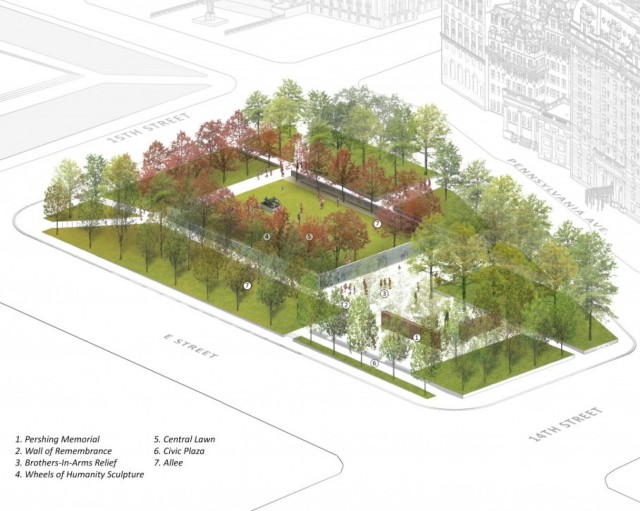
Winning entry in competition to design a national WWI memorial in D.C.
Yesterday’s announcement of a winner in the open international competition for a national World War I memorial sent me rushing to find out how it had changed since its selection as one of five finalists. And the winner is Joseph Weishaar, a 25-year-old graduate of the architecture school at the University of Arkansas at Fayetteville. He had never been to Washington, D.C. – where the memorial is to be erected – before his selection as a finalist in August.
The image accompanying a New York Times’s story, “National World War I Memorial Proposal Is Unveiled,” looks little different from when it was a finalist (and it may be an image taken from Phase I of the competition). For Phase II, Weishaar hired the prominent sculptor Sabin Howard, of New York City, which caused some traditionalists to suppose that, with Howard aboard, the Weishaar design, called “Weight of Sacrifice,” might join the Annapolis architect Devin Kimmel’s classical “Grotto of Remembrance” design as worthy of the support of traditionalists.
Based on the images I have seen, I cannot tell. For now, “Weight of Sacrifice” seems little more than a sculpture in a rectangular lawn upheld by walls of bas reliefs of soldiers and other WWI imagery interspersed with engraved quotations from politicians, generals, common soldiers and folks back home. Without the figurative sculpture, the architect’s submission would resemble Maya Lin’s dark wall of names of the dead from the Vietnam war … but, oh yes, they did add statues of soldiers to that, too. And in this memorial, we’re informed that its number of cubic feet will record the number of Americans who died in the European “war to end all wars.”
I’m sure that sculptor Howard will improve on what Weishaar wrought. But the jury’s choice was clearly an exercise in caution, with forces supporting preservation of its proposed location, Pershing Park, near the White House, threatening to sue to block the new memorial. Pershing Park, deteriorated over the years, was designed by the modernist landscape architect M. Paul Friedberg and opened in 1981. Citizens of Kansas City, where another WWI memorial anointed “national” by act of Congress, are gnashing their teeth as well. It doesn’t look as if the winning design has survived its final battle, even though it preserves more of Friedberg’s park than any other finalist.
The Washington Post’s architecture critic, Philip Kennicott, wrote “America Is Chock Full of WWI Memorials, So Why Build Another?” It is a silly question. Most of those are local or regional, such as the elegant bandstand near the Reflecting Pool of the Washington Monument, or commemorate a lofty historical figure from WWI, such as Gen. John “Black Jack” Pershing.
The last thing Kennicott wants, or that the jury wanted, obviously, was to give the nod to a classical design that would have stood in apposition to the controversial Eisenhower memorial proposal designed by Frank Gehry. How awkward it would have been for the modernist establishment if the public had finally got a gander at what classical architecture can do. A project that the architectural media would have been unable to cover up, as they did the Franck Lohsen McCrery proposal, published in the Manhattan Institute’s quarterly City Journal, to rebuild the World Trade Center back in 2002.
Such a design as Kimmel’s “Grotto of Remembrance” would have struck such a chord with the public, would have made its way – for that reason – so easily through the approval process, that modern architecture would have received a black eye unlike it had ever got before in recent design history. Kimmel’s design touched all of the bases. It was heroic, legible with ease to the broad public, sufficiently grand to reflect history’s judgment, sufficiently somber to balance the glory of a war memorial, appropriate to its place in the pantheon of war memorials in the nation’s capital, sensitive to the context of its site near the White House, faithful to each of the United States World War One Centennial Commission’s ten goals and, not least, beautiful.
(By the way, and perhaps apropos of nothing, the Centennial Commission’s “founding sponsor” is the Pritzker Military Museum & Library, in Chicago.)
Immediately after the five finalists were named, I wrote a post, “Finalists for WWI memorial” (click on the link in my last post, “WWI jury’s memorial error“) that described them all. Even then I was certain that Kimmel’s design deserved to win. I regret that it didn’t, and not just because I was later asked to join his design team. It leaves the classical revival without its next major positive project (as opposed to negative opposition to Gehry’s Ike).
On second thought, in fact, the classical revival’s next major positive project is rarin’ to go. Justin Shubow, president of the National Civic Art Society, just yesterday published his latest piece for Forbes: “It’s Time to Rebuild New York’s Original Penn Station.” … Good timing, Justin!



i lke your article , very inspiring, and thank you for your post
LikeLike